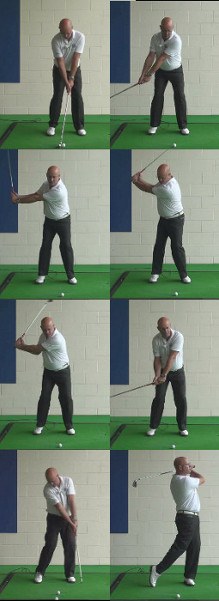You're Correct!
 The connected swing is the long term aim for the majority of golfers - a powerful, consistent, ball striking golf swing that works week on week. So what is a connected golf swing?
The connected swing is the long term aim for the majority of golfers - a powerful, consistent, ball striking golf swing that works week on week. So what is a connected golf swing?
A connected golf swing helps a golfer use the bigger muscles to power the swing whilst keeping the arms close, helping to eliminate inconsistent shots. When you tell the majority of golfers to keep their swing connected and their arms close to their body, they instinctively stop all body rotation and bend their arms around the body thus promoting worse strikes and much less distance.
To develop a connected golf swing you need the bigger muscles to initiate the swing, starting with the shoulders and the left arm pushing the club back in a straight line, keeping the left arm straight. The back swing should have a 90 degree shoulder turn with approximately a 45 degree hip turn. This tension at the top of the swing is a build up in power for the hips to initiate the down swing.
A connected top of the back swing position sees the shoulders rotate to 90 degrees with the left arm straight and the right arm bent to just below 90 degrees and close into the body. There are many drills for this including the towel drill.
The towel drill is executed by putting one towel across your chest and under both arm pits and trying to swing using the big muscles such as hips and shoulders. Be aware that you still need to feel the lifting of your arms at the top of the back swing. Use a mirror to help see the 90 degree shoulder turn, with a straight left arm covering your right shoulder and a 45 degree hip turn. This swing delivers width, power, connectivity and longevity in your golf game.
Sorry Try Again! - See Explanation Below
Every swing change, whether it is big or just a small tweak, can be developed. If golfers all swung how they naturally picked up the club, they would all be playing at a very low standard. Swing changes can be developed and even big changes can be developed over a short space of time with the correct practise drills and routines. More importantly, understanding the changes that you need to make and why they need to be made is essential.
Sorry Try Again! - See Explanation Below
A connected golf swing does not require you to get the club and your hands attached to your shoulder or neck at the top of the swing. A connected golf swing means the body moving as one using the big muscles to create power, width and consistency.
The hands on the right shoulder at the top of the swing might seem like you have a connected swing, however this position just causes a weak back swing and therefore down swing. Not only is this position weak, it causes an inconsistent angle of attack and swing path leading to poor strikes and shots.
Sorry Try Again! - See Explanation Below
It is easy to take the connected swing too far and totally attached your right elbow to your body throughout the swing which will have negative implications with contact on the ball and distance created.
To get your elbows attached to your body at the top of the swing you need to bend your left arm around your chest, so straight away you have lost the width and build up on tension of the back swing. On the down swing, the right arm will break through impact causing a poor extension through the ball. This swing will do everything a connected swing shouldnt do so make sure you do not confuse a connected swing with tight and limited swing.
The arms need the freedom to move but also need to be set in a good strong wide position where they are still connected to the body in such a way that delivers consistency and power. If we keep the arms glued to the body it then becomes robotic and powerless.






